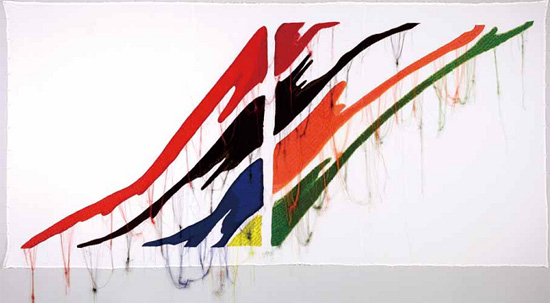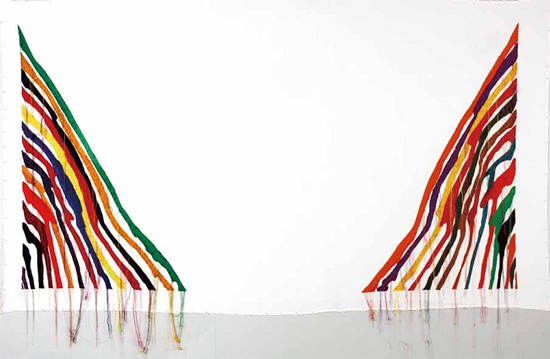|
Introduction of the artist:

HAM Kyungah (South Korea)
Born in 1966, Seoul, Korea. Works and lives in Seoul. Selected solo
exhibitions: 2009 Desire and Anesthesia, Artsonje Center, Seoul / Selected group
exhibitions: 2012 Busan Biennial, Korea / 2012 Liverpool Biennial, UK / 2011
Singapore Biennale / 2010 Hyper Real, MUMOK, Wien / 2009 Asia Pacific Triennial,
Australia/ 2009 Prague Biennial / 2006 the 6th Gwangju Biennial, Korea/ 2006
Naked Life, Taipei MOCA, Taiwan / 2005 Seoul: Until Now!, Charlottenborg Hall,
Copenhagen / 2001 Text & Subtext, Artspace, Sydney, Stenersen Museet, Oslo
and Tasiatiska Museet, Stockholm / 2001 Image of Asia, Kunsthallen Nikolaj,
Copenhagen / 2002 the 4th Gwangju Biennial, Korea / 2001 the 1st Yokohama
Triennial, Japan / the 1st Tirana Biennale, Albania.
Introduction of works:

Abstract Weave - Louis Morris, Alpha Epsilon 1960, North Korean Embroidery,
news articles, cotton, 410×200cm, 2012

Abstract Weave - Louis Morris, Alpha Lambada 1961, North Korean Embroidery,
news articles, cotton, 350×200cm, 2012
In the era of digital technology, it becomes very easy to source information
and to communicate with each other, sometimes, too easy. The world today,
however, remains largely unseen to North Korea with the Internet only available
to a few, and to many of us, the country seems to be almost a mystery. When the
political situations between North and South Korea provide little accessibility
for any means of communications, it becomes an extreme challenge for Ham
Kyungah, a South Korean artist, who takes a personal risk to establish a
dialogue with the North through her artistic practice.
Apart from the various reports on North Korea that smaller cities lack
regular electricity and food and malnutrition remains widespread, people are
restricted to read any textual or visual materials outside the state. Ham
Kyungah collects and transcribes daily news articles from the Internet and
manipulates her manuscripts with abstract paintings, for example, by Morris
Louis, into digital prints, where the text can be concealed sneakily in the
colourful patterns. The designs are then sent through some secret negotiations
and deals, which demand additional commissions, to get them embroidered by North
Korean workers, who have to read and re-interpret some quickly produced and
hidden information very deliberately in one of the slowest ways. Completed
embroidery returning to the artist can be strictly censored, and sometimes,
simply confiscated or destroyed at the border by the authorities. The whole
process might take much longer than initially expected with the potential of no
‘artwork’ as a result.
The production of the embroidery is no longer important, where this process
opens a new range of perspectives in the political context to critically discuss
the rights for equality in communication, and for seeing and being seen.
| 
